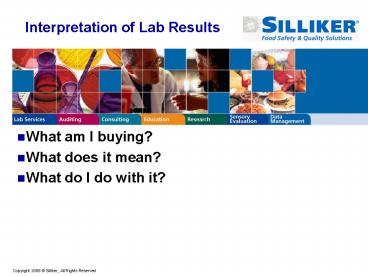Interpretation of Lab Results - PowerPoint PPT Presentation
1 / 22
Title:
Interpretation of Lab Results
Description:
To even begin to interpret lab results we need some understanding of measurement ... tells us the interval in which the true value is likely top fall. So... – PowerPoint PPT presentation
Number of Views:73
Avg rating:3.0/5.0
Title: Interpretation of Lab Results
1
Interpretation of Lab Results
- What am I buying?
- What does it mean?
- What do I do with it?
2
Reasons for Testing
- Regulatory Compliance
- Process Verification / Change
- Stability Studies
- Problem Investigation
- Due diligence
- Other?
3
Interpretation
- To even begin to interpret lab results we need
some understanding of measurement uncertainty.
4
Measurement Uncertainty
5
BUT FIRST
- This presentation is not about mathematics
- The formal approach to measurement uncertainty
estimation calculates a measurement uncertainty
estimate from an equation, or mathematical model.
The procedures described as method validation are
designed to ensure that the equation used to
estimate the result, with due allowance for
random errors of all kinds, is a valid expression
embodying all recognized and significant effects
upon the result. It follows that, with one caveat
elaborated further below, the equation or model
subjected to validation may be used directly to
estimate measurement uncertainty. This is done by
following established principles, based on the
law of propagation of uncertainty which, for
independent input effects is - where y(x1,x2,..xn) is a function of several
independent variables x1,x2,..., and ci is a
sensitivity coefficient evaluated as ci ?y/?xi,
the partial differential of y with respect to xi.
u(xi) and u(y) are standard uncertainties, that
is, measurement uncertainties expressed in the
form of standard deviations. Since separate
uy(x1,x2,... is a function of several
uncertainty estimates, it is referred to as a
combined standard uncertainty.
6
But
- It helps if you know some math
- Means
- Standard Deviations
- Square root of sum of squares
7
This presentation
- Is not about The Standard
- 5.4.6.2 Testing laboratories shall have and
shall apply procedures for estimating uncertainty
of measurement.Reasonable estimation shall be
based on knowledge of the performance of the
method and on the measurement scope and shall
make use of, for example, previous experience and
validation data. - 5.4.6.3 When estimating the uncertainty of
measurement, all uncertainty components which are
of importance in the given situation shall be
taken into account using appropriate methods of
analysis.
8
But
- We should know the lab requirements
- Must have and apply a procedure for estimating
uncertainty - Must report uncertainty when required
- Must consider all sources of uncertainty
- Must not mislead clients as to the uncertainty of
a result
9
Definition
- Uncertainty is a parameter associated with a
measurement that characterizes the dispersion of
the values that could be reasonably attributed to
the measurand - VIM
10
What is measurement uncertainty?
- Its not error
- Error is a quantity the distance of a result
from the true value - Error deals with a single measurement
11
Uncertainty vs. Error
- Error tells us how much the result differs from
the true value - Uncertainty tells us the interval in which the
true value is likely top fall
12
So
- Uncertainty is a quality
- A property of the analytical system (method)
- the range of values that the analyst feels could
reasonably be attributed to our result
13
Therefore
- This presentation is about feelings
14
Sources of Uncertainty in Analysis
- Sample inhomogeneity
- Incomplete extraction
- Analyte decomposition, volatilty, adsorption
- Contamination
- Uncertainty of standards
- Instrument drift
- Carryover
- Imperfect selectivity (cross-talk)
15
Other considerations
- What the uncertainty does not include
- Field variability and transport
- Gross in lab errors blunders
16
Other considerations
- Near the detection limit the uncertainty world
changes - Uncertainty applies only to normal samples
17
Why does it Matter?
18
Comparison to a regulatory limit
19
Comparison of Results
Difference?
No Difference?
20
Considerations
- Risk of a false non-compliant finding (alpha
error) - Risk of a false compliant finding (beta error)
- How was the limit/specification set?
- With uncertainty in mind?
- Performance properties of the analytical method
21
Lesson Learned
- You are not buying a number but rather, a range
that the number may be in - The range gives you a probability of
compliance/non-compliance - Confer with the lab ahead of time to use a method
that gives the (un)certainty required for a good
decision - You (or the regulator) decides based on the
probability of error. The Decision Limit.
22
Questions?
- Contact Information
- Walter Brandl
- Silliker JR Labs
- walter.brandl_at_silliker.com
- 604-432-9311































